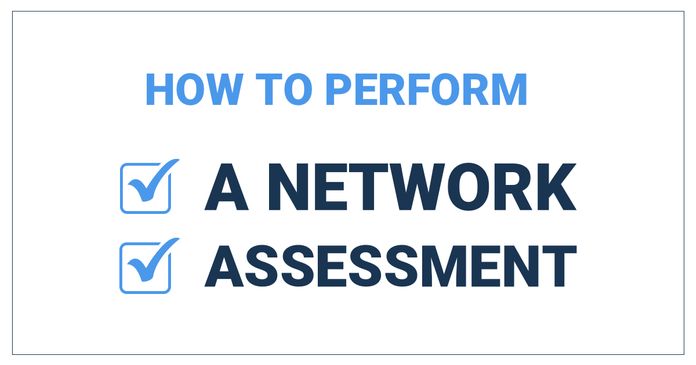Table of Contents
Table of Contents
In this age of rapid technological advancement, businesses rely heavily on their networks to thrive in the digital landscape. Whether you're a startup, a small enterprise, or a multinational corporation, the efficiency and speed of your network can make all the difference in achieving success or getting lost in the digital abyss.
Now, picture this: You're on the verge of sealing that groundbreaking deal, but suddenly, your network decides to take an impromptu vacation, leaving you stranded in a digital desert. Frustrating, isn't it? But fret not, for we are here to equip you with the knowledge and tools to improve your network performance from sluggish into a supersonic highway of data transmission!
In this blog post, we will unravel the mysteries around how to improve network performance and provide you with practical tips, tricks, and a dash of nerd-inspired magic to revitalize your digital infrastructure. Together, we will embark on a quest to banish buffering circles, vanquish latency monsters, and embrace a network that flows like a symphony of synchronized data.
Just so we’re on the same page, we’re going to give you a quick definition of network performance.
Network Performance is "the analysis and review of collective network statistics, to define the quality of services offered by the underlying computer network [that is] primarily measured from an end-user perspective."
Our network pros have years of experience working with networks, and so we put together our own definition. More simply, network performance refers to the analysis and review of network performance as seen by end users.
There are three important concepts in that definition:
- Network Analysis and Review: In order to analyze and compare network performance measurements over time, it is essential to initially measure key network metrics that are linked to network performance and gather a comprehensive record of the measured data.
- Measuring Network Performance: Network performance denotes the overall standard of a network, and this standard can differ based on the specific location within the network where measurements are conducted. For instance, comparing the performance of a route between Montreal and New York with that of a route between Montreal and Tokyo will yield varying levels of quality. Additionally, network quality is also subject to fluctuation based on the timing of measurements. Thus, your network performance might exhibit excellence during the early hours of the workday when user activity is low, but experience degradation as more users come online later in the day.
- The End-User Experience: When it comes to assessing network performance, the ultimate priority lies in the end-user experience. However, simply obtaining information about user experiences is insufficient. By employing suitable monitoring tools, we have the ability to transform the user experience into quantifiable metrics and utilize those measurements to identify areas that require enhancement.
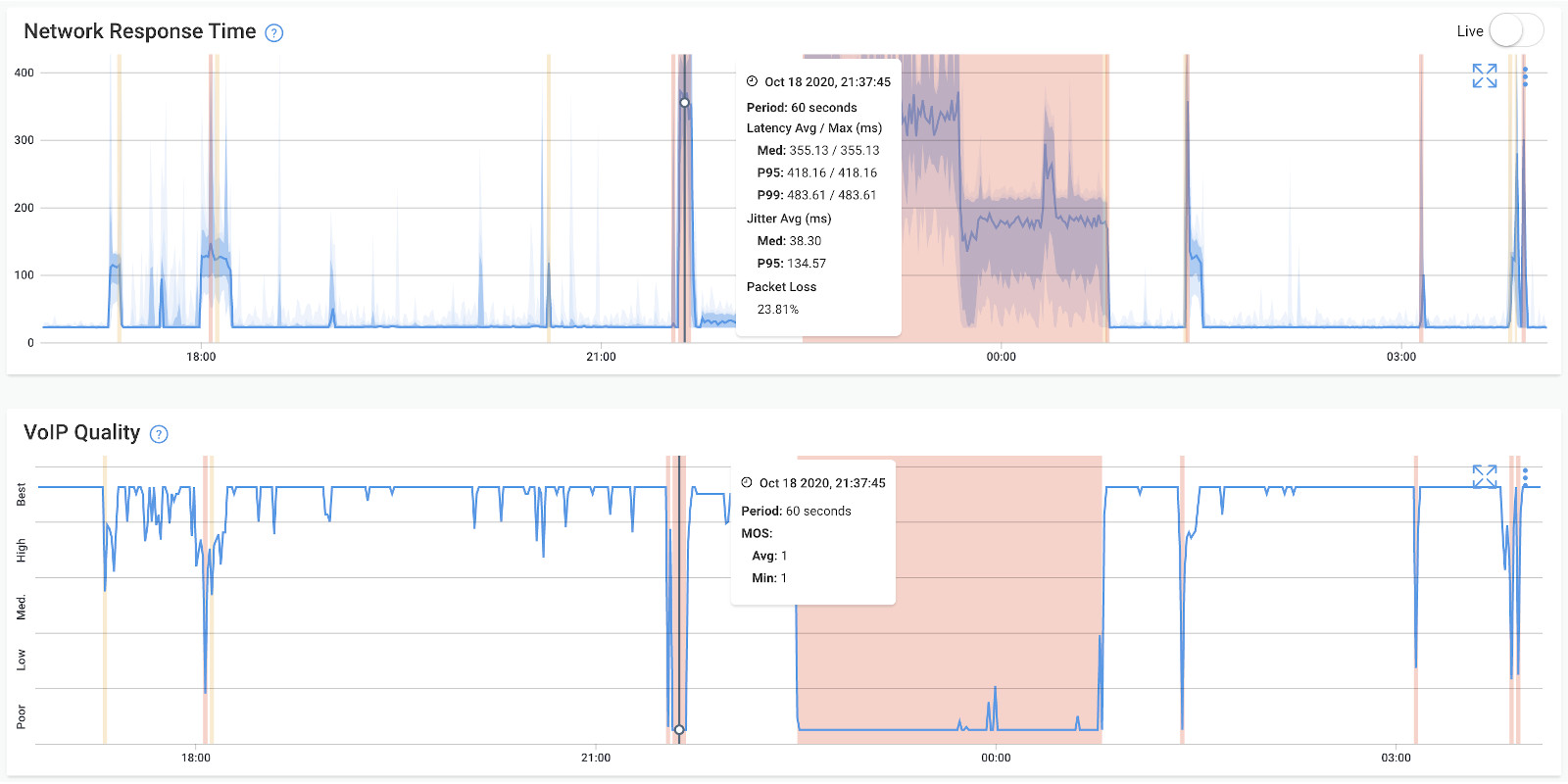

Welcome, to the realm of network performance improvement! In this section, we explore why improving network performance is vital for your success. A high-performing network drives productivity, enhances customer satisfaction, ensures reliable communication, provides secure data access, and paves the way for scalability and future growth.
- Enhanced Productivity: A high-performing network ensures smooth and efficient communication and data transfer within an organization. It allows employees to collaborate seamlessly, access resources quickly, and complete tasks without unnecessary delays. By minimizing network-related obstacles, productivity levels can soar, leading to more efficient operations and improved overall performance.
- Customer Satisfaction: In today's interconnected world, businesses heavily rely on digital interactions with customers. Whether it's delivering online services, providing real-time support, or ensuring fast and reliable transactions, a robust network is essential for delivering a positive customer experience. By improving network performance, businesses can enhance customer satisfaction, build trust, and gain a competitive edge in the market.
- Reliable Communication: Clear and reliable communication is vital for any organization. A well-performing network enables smooth voice and video conferencing, instant messaging, and collaboration tools. It ensures that crucial business communications occur without disruptions, enabling teams to make informed decisions quickly and efficiently.
- Data Accessibility and Security: With the increasing volume of data generated and stored by organizations, network performance plays a crucial role in data accessibility and security. A robust network facilitates fast and reliable access to data, enabling employees to retrieve and utilize information when needed. Additionally, a secure network is essential for safeguarding sensitive data from unauthorized access, ensuring data integrity and compliance with privacy regulations.
- Scalability and Future Growth: As businesses evolve and expand, their network infrastructure needs to accommodate growing demands. By improving network performance, organizations can optimize their network's scalability, ensuring it can handle increased data traffic, accommodate new devices, and support emerging technologies. This scalability is crucial for future growth and adaptability in a rapidly evolving digital landscape.
Overall, improving network performance empowers organizations to operate at their full potential, deliver exceptional user experiences, and stay ahead in today's fast-paced and digitally-driven business environment.
Networks are large, complex infrastructures that support a variety of different applications, users, and services. Because of that, there are so many different factors that can affect network performance - and you can’t catch them all by yourself.
Businesses need a solution to monitor their network performance to identify network issues and detect areas for improvement. They need Network Performance Monitoring.
An NPM tool provides real-time visibility into your network infrastructure, allowing you to monitor and analyze network performance metrics continuously. It enables you to track bandwidth utilization, latency, packet loss, device performance, and other critical parameters. With real-time insights, you can quickly identify bottlenecks, diagnose issues, and take immediate corrective actions.

Obkio Network Performance Monitoring software monitors end-to-end network performance so you can monitor performance from your local network (LAN, VPN), as well as third-party networks (WAN, ISP, and Internet Peering).
Deploy Network Monitoring Agents in your key network locations (head office, remote offices, data centers) to monitor end-to-end network performance and:
- Measure core network metrics
- Continuously test your network for performance degradation
- Proactively identify network issues before they affect users
- Simulate user experience with synthetic traffic & synthetic testing
- Collect data to help with network troubleshooting
- Compare network changes with historical data
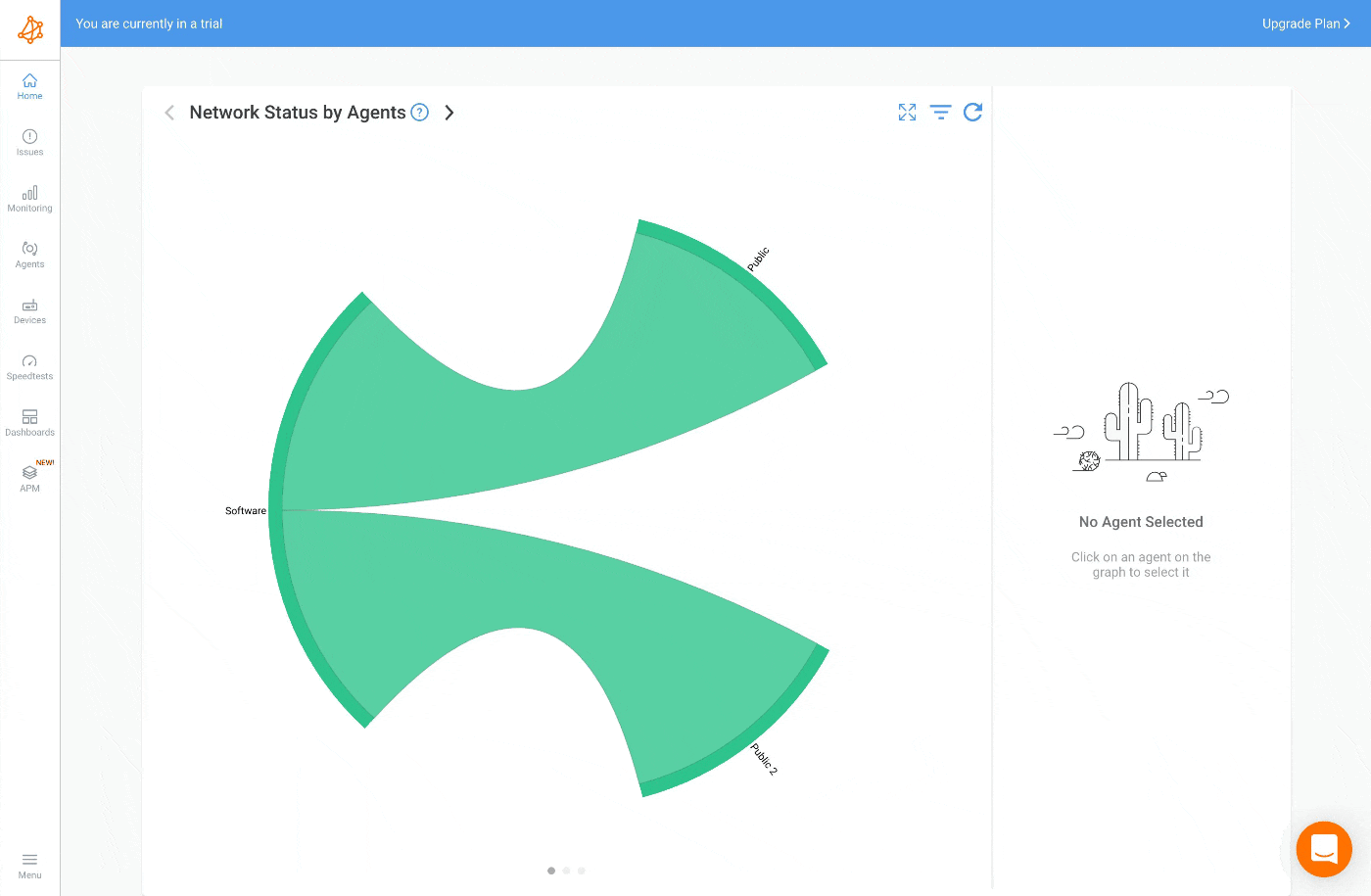
Ready to level up your network performance? Unleash the power of seamless connectivity with Obkio! Say goodbye to buffering circles and hello to lightning-fast speeds. Try Obkio today and embark on a network performance revolution!

Obkio’s Network Monitoring Solution continuously monitors network performance by sending and monitoring data packets through your network every 500ms using Network Monitoring Agents deployed in your most important network locations like:
- Remote Offices
- Data Centers
- Cloud apps
- UC apps (like Zoom performance)
- Over the Internet
Network Monitoring Agents exchange continuous synthetic traffic to catch network issues as soon as they happen - even if they only appear for a few minutes. Obkio will then alert you if and when network problems are identified to you can troubleshoot and improve network performance.
- Local Agents (Windows, MacOS, Linux, Hardware) are installed at key network locations such as branch offices, data centers, remote locations to monitor performance.
- Public Monitoring Agents are Agents installed in Service Provider networks (like AWS, Google, and Azure). They can be used to monitor the performance of any branch externally towards the Internet (without passing through the head office).
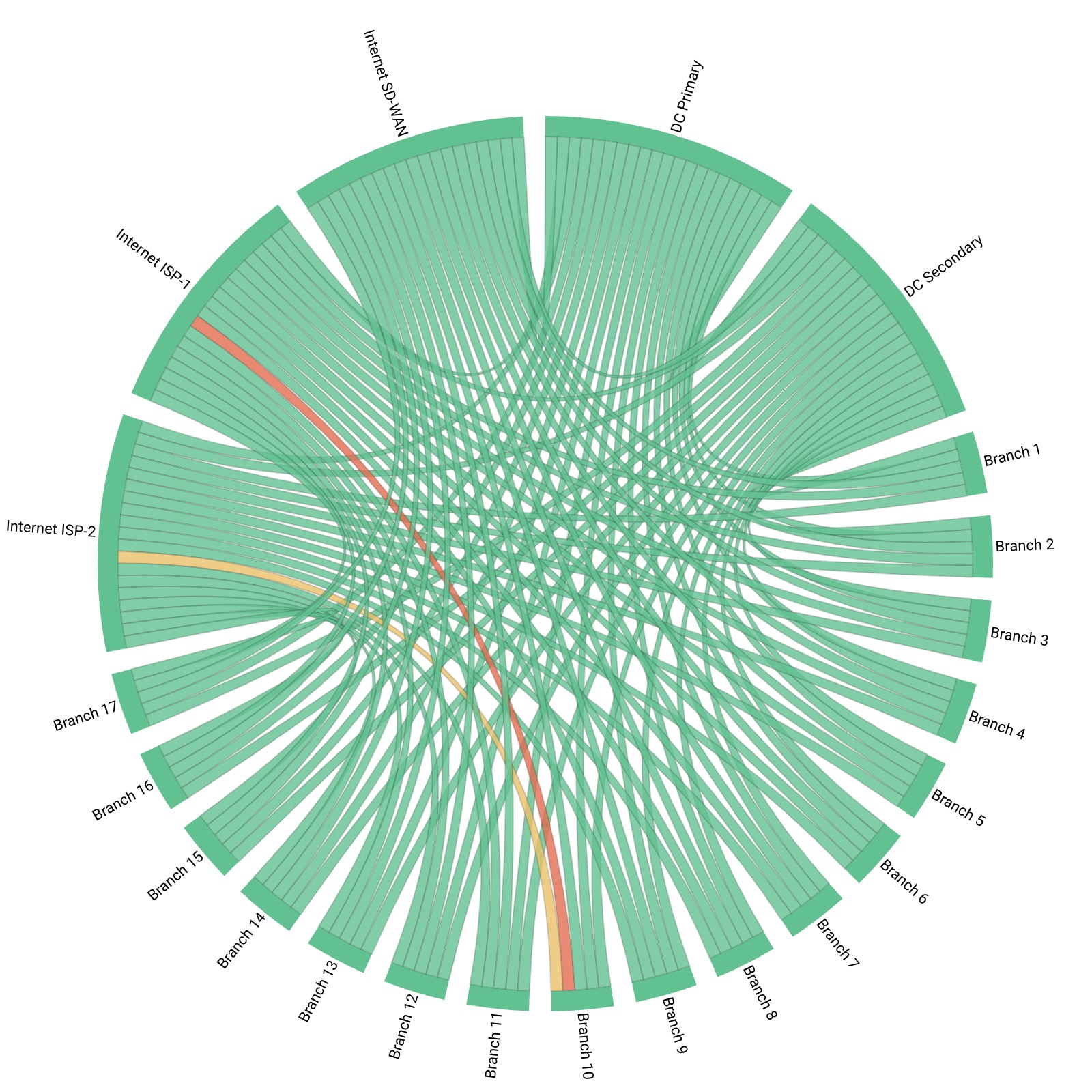
An important step in when improving network performance is to measure a series of key network metrics, which will help you identify any issues in your network that you need to address.
Once you’ve deployed Obkio Monitoring Agents in key network locations, they will continuously measure key network metrics like:
- Bandwidth Utilization: Keep an eye on how much of your available bandwidth is being used at any given time. High bandwidth utilization can lead to congestion and performance issues.
- Latency: Monitor the round-trip time it takes for data packets to travel between source and destination. Higher latency can cause delays in data transmission, impacting the responsiveness of applications.
- Packet Loss: Track the percentage of packets lost during transmission. Excessive packet loss can result in data retransmission, leading to performance degradation.
- Jitter: Measure the variation in latency over time. High jitter can cause inconsistent delivery of data packets, leading to disruptions in real-time applications like VoIP or video conferencing.
- Network Congestion: Monitor network congestion levels to identify areas where network traffic exceeds available capacity. Congestion can cause delays, packet loss, and decreased performance.
- Network Errors: Keep an eye on error rates, such as CRC errors or dropped packets. High error rates indicate potential issues with the network infrastructure that can affect performance.
- Throughput: Measure the amount of data transmitted over a given period of time. Monitoring throughput helps identify if the network is delivering data at the expected rate and capacity.
- Response Time: Monitor the time it takes for a system or application to respond to a request. Slow response times can indicate performance issues that need attention.
- Device Performance: Assess the performance of network devices, such as routers, switches, or firewalls. Monitoring device metrics, such as CPU usage, memory utilization, and interface errors, can help identify any performance bottlenecks.
- Application Performance: Measure the performance of critical applications running over the network. Monitoring metrics like application response time, throughput, and error rates provides insights into application performance and its impact on overall network performance.
Obkio will then display them on Obkio’s Network Response Time Graph. so you have a clear picture of what metrics you need to improve to optimize network performance. By monitoring these network metrics, you can gain visibility into the health and performance of your network infrastructure. This enables you to proactively identify and address issues, optimize network resources, and ensure a reliable and high-performing network environment.
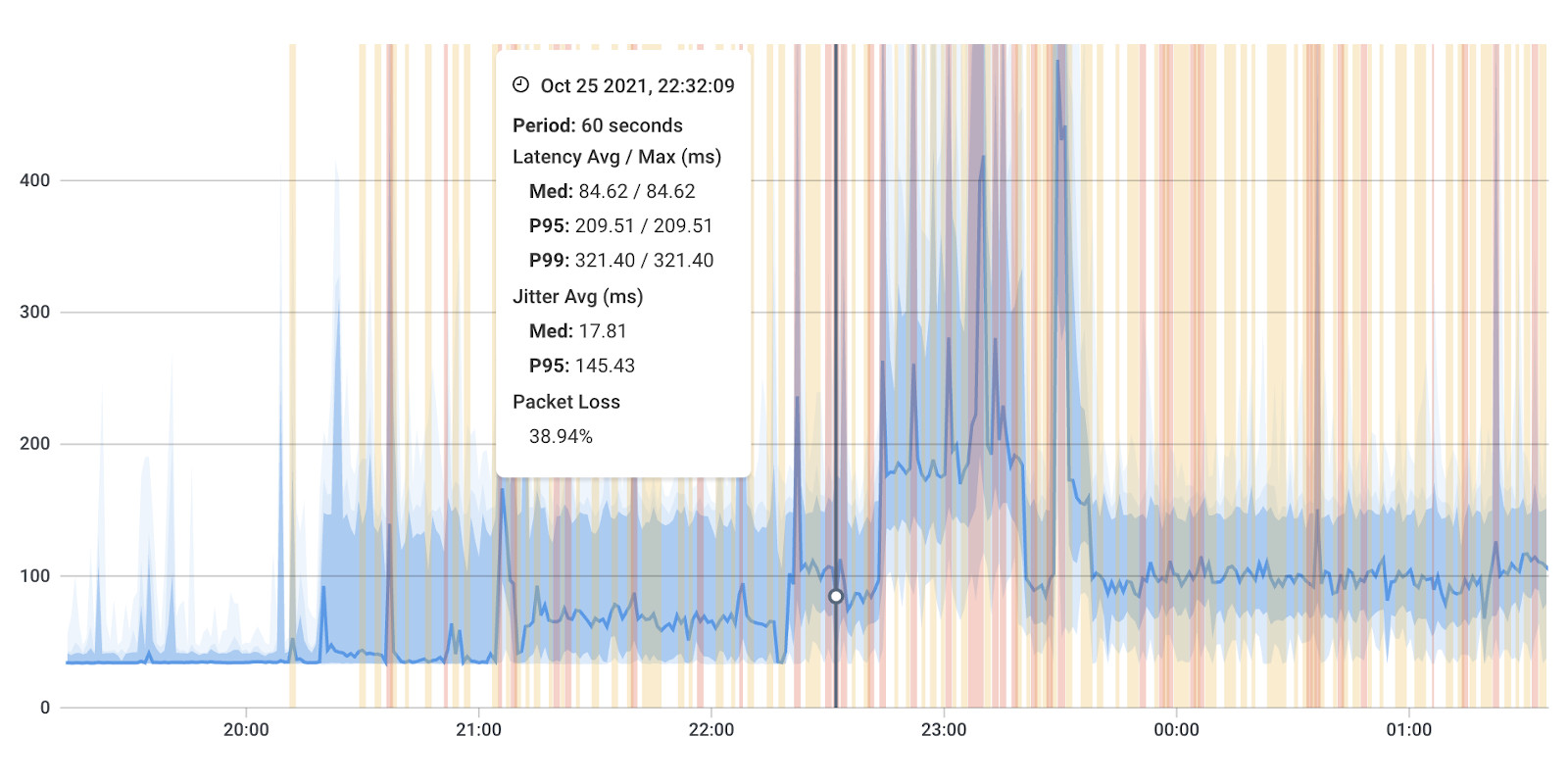

In the list of metrics above, you may have noticed Network Device Metrics. That’s because monitoring network devices is another important part of improving network performance. Many network issues can be related to network devices, so it’s important to keep an eye on those too.
Obkio’s Network Device Monitoring feature is a fast and easy solution to get detailed information about the performance of your core network devices such as routers, switches, firewalls, and more, to quickly and proactively pinpoint and troubleshoot network device issues like congestion, high CPU and interface errors.
When you’re looking to improve network performance, you need to monitor network device metrics like:
- CPU Utilization: Monitor the CPU usage of network devices, such as routers, switches, or firewalls. High CPU utilization can indicate processing bottlenecks and potential performance issues.
- Memory Utilization: Track the memory usage of network devices. Insufficient memory can lead to performance degradation and impact the device's ability to handle network traffic effectively.
- Interface Utilization: Monitor the utilization levels of network interfaces. High interface utilization may indicate network congestion or inadequate bandwidth allocation.
- Error Rates: Keep an eye on error rates, such as CRC errors or interface errors. High error rates can indicate issues with network connectivity, cable quality, or device configuration that can impact performance.
- Packet Discards: Monitor the number of discarded packets on network interfaces. Excessive packet discards can indicate interface congestion or buffer overflows, leading to performance degradation.
- Interface Errors: Track the number of interface errors, such as collisions or input/output errors. High interface error rates may suggest issues with cabling, hardware problems, or configuration errors.
To actually understand if and how to improve your network performance, perform a network assessment to assess your current network infrastructure and identify any performance bottlenecks or areas for improvement.
A network assessment is an in-depth network infrastructure analysis to collect and analyze comprehensive data about your network’s health, including current network issues, any signs of network performance degradation, and places for improvement or network optimization.
Obkio’s NPM tool will be your best friend for this task!
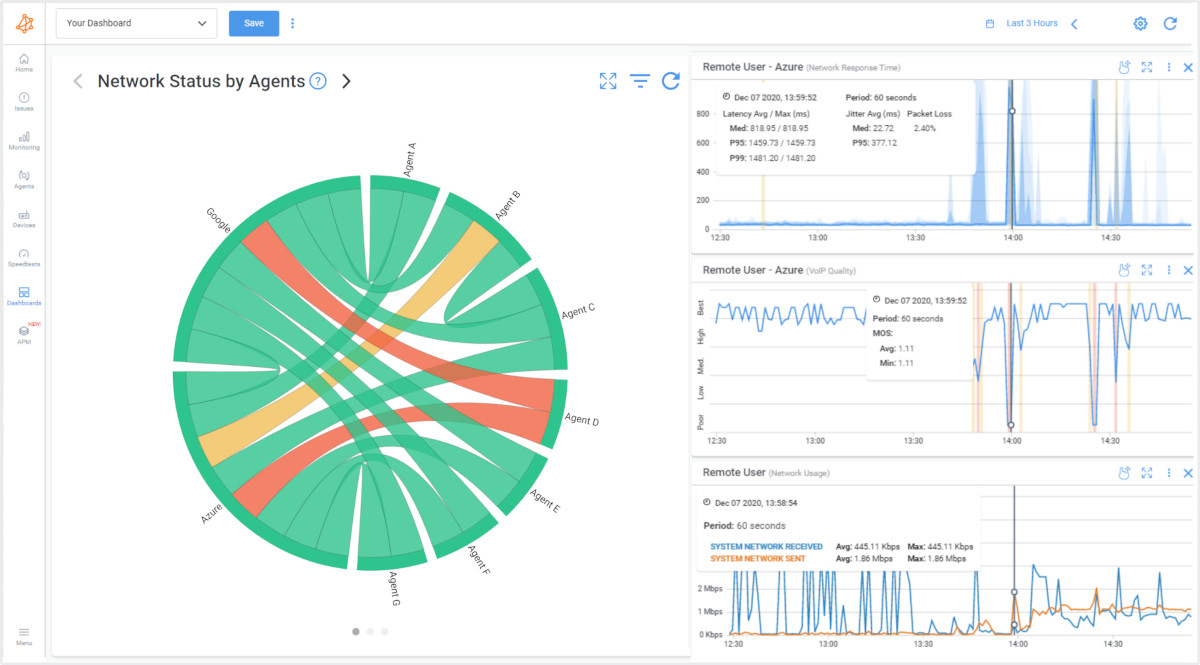
Here are some key aspects to consider when conducting a network assessment:
- Identify Network Components: Begin by documenting and identifying all network components, including routers, switches, firewalls, access points, and servers. Understand the network topology and how these components are interconnected.
- Map Network Traffic: Analyze network traffic patterns to identify areas of high utilization, congestion, or bottlenecks. Use network monitoring tools to capture and analyze traffic flows, identifying peak usage periods and potential performance limitations.
- Measure Bandwidth Utilization: Determine how bandwidth is utilized across different network segments or links. Identify if any links are consistently operating at maximum capacity, leading to congestion and performance degradation.
- Assess Latency and Round-Trip Time: Measure latency and round-trip time (RTT) between network devices. High latency or prolonged RTT can impact application responsiveness and user experience. Identify areas with excessive delays and potential causes.
- Evaluate Packet Loss and Jitter: Measure packet loss and jitter to understand the quality of data transmission. Excessive packet loss or significant jitter can impact the reliability and performance of real-time applications such as VoIP or video conferencing.
- Review Network Security: Assess the network security measures in place, including firewalls, intrusion detection systems, and access controls. Identify any vulnerabilities or gaps in security that may impact network performance.
- Analyze Network Configuration: Review network device configurations to ensure they are optimized for performance. Check for proper VLAN setup, routing protocols, QoS configurations, and other settings that influence network performance.
- Consider Network Scalability: Evaluate the network's ability to scale and accommodate future growth. Assess if the current infrastructure can handle increasing demands, such as additional users, devices, or data volume.
- Identify Single Points of Failure: Identify any single points of failure in the network architecture. Determine if redundant paths, network failover mechanisms, or backup systems are in place to ensure network reliability and minimize downtime.
- Collect Performance Baseline: Establish a performance baseline by collecting data over a period of time. This baseline provides a reference point for future comparisons and helps track the impact of performance improvement efforts.
- Analyze Network Documentation: Review existing network documentation, including network diagrams, configurations, and change logs. Ensure the documentation is accurate and up to date, aiding troubleshooting and future network management.
- Gather User Feedback: Consider gathering feedback from end-users regarding their experience with the network. Identify any pain points, performance issues, or specific areas of concern that can guide improvement efforts.
By conducting a thorough network assessment, you can identify specific areas of improvement and develop a targeted strategy to enhance network performance. The assessment serves as a foundation for implementing changes, optimizing configurations, and addressing any identified performance limitations.
Learn how to perform a network assessment with Obkio Network Monitoring to optimize network performance for a new service deployment or migration.
Learn more

With all the information you collected by measuring network metrics and performing a network assessment, you can now identify any network issues affecting your network performance. Network Performance Monitoring tools, like Obkio, proactively detect and alert you about potential network issues before they escalate into major problems. By setting up thresholds and triggers, these tools can automatically notify you when performance metrics deviate from normal ranges. This enables you to address issues promptly, reducing downtime and minimizing the impact on user experience.
Identify network issues affecting network performance such as:
- Network Congestion: Network congestion occurs when there is excessive traffic on the network, leading to performance degradation. Congestion can result from bandwidth-intensive applications, inadequate network capacity, or inefficient traffic management.
- Bandwidth Limitations: Insufficient bandwidth can cause slow data transfer speeds and delays in accessing network resources. Limited bandwidth may be due to network infrastructure constraints or improper allocation of bandwidth to critical applications.
- Latency: Latency refers to the delay in data transmission between source and destination. High latency can result from long network distances, inefficient routing, or network congestion. It can negatively impact real-time applications, such as VoIP (VoIP latency) or video conferencing.
- Packet Loss: Packet loss occurs when data packets are dropped during transmission. It can be caused by network congestion, faulty hardware, or network errors. Packet loss can result in data retransmission, reduced application performance, and degraded user experience.
- Network Errors: Network errors, such as CRC errors or input/output errors, indicate problems in data transmission. These errors can be caused by physical issues like faulty cables, loose connectors, or electromagnetic interference, impacting network performance.
- Misconfigured Devices: Misconfigurations in network devices, such as routers or switches, can lead to performance issues. Improper settings, incorrect routing protocols, or suboptimal configurations can impact network stability and throughput.
- Security Threats: Security threats, including malware, viruses, or denial-of-service (DoS) attacks, can significantly impact network performance. These threats consume network resources, disrupt communication, and may cause network downtime.
- Hardware Failures: Hardware failures, such as faulty network interfaces, power supply issues, or failing components, can lead to network performance degradation. Hardware failures can disrupt network connectivity and impact the overall network reliability.
- Legacy Equipment: Outdated or legacy network equipment may lack the capabilities to handle increasing data volumes and advanced networking requirements. Aging hardware or software may limit performance and hinder network scalability.
- Improper Network Design: Poor network design, including suboptimal routing, improper segmentation, or inefficient use of network resources, can lead to performance bottlenecks. Inadequate network design fails to support the required traffic patterns and user demands.
- Network Accessibility: Issues related to network accessibility, such as network downtime, limited connectivity, or intermittent network disconnections, can significantly impact network performance. Unreliable network access prevents smooth communication and hampers productivity.
I addition to information about the actual network problems themselves, you can also collect data that will help you understand where to direct your network optimization efforts, and what actions to take, such as:
- What the problem is
- Where the problem is located
- When the problem occurred
- Who is responsible for this network segment
- What actions to take


Pro-Tip: Obkio allows you to set up automatic alerts for network problems, or when there’s a sign of network performance degradation so you know exactly when it’s time to start improving your network performance.
- Thresholds and Triggers: Set thresholds and triggers based on performance metrics. These thresholds define the acceptable ranges for each metric. When a metric exceeds or falls below the defined threshold, a trigger is activated, indicating a potential issue.
- Alerting and Notifications: When a trigger is activated, get alerts and notifications to inform you about the deviation from normal performance. These alerts can be delivered via email, SMS, or through dedicated alerting systems, ensuring that you are promptly informed about the issue.
- Proactive Issue Identification: By receiving alerts and notifications, you can quickly identify potential network issues, even before users report them. This proactive approach enables you to take immediate action to investigate and resolve the problem, minimizing the impact on network performance and user experience.
Of course, one of the most obvious ways of improving network performance is by troubleshooting network issues affecting your network performance.
The steps you take to troubleshoot will depend on the type of network issue you discovered in the previous steps, here is a recap of How to Troubleshoot Network Issues using Obkio’s solution.
To start troubleshooting network issues, you need to confirm if the problem is indeed related to the network. One way to do this is by comparing the monitoring sessions between the different Monitoring Agents you've deployed in your network. This will help you determine if the issue is isolated to a specific area of the network or if it's a broader problem.
In the screenshot below, you’ll see an example of a Network Session with no network issue. As a reference, this is what it looks like when the network isn’t the cause of your problem.
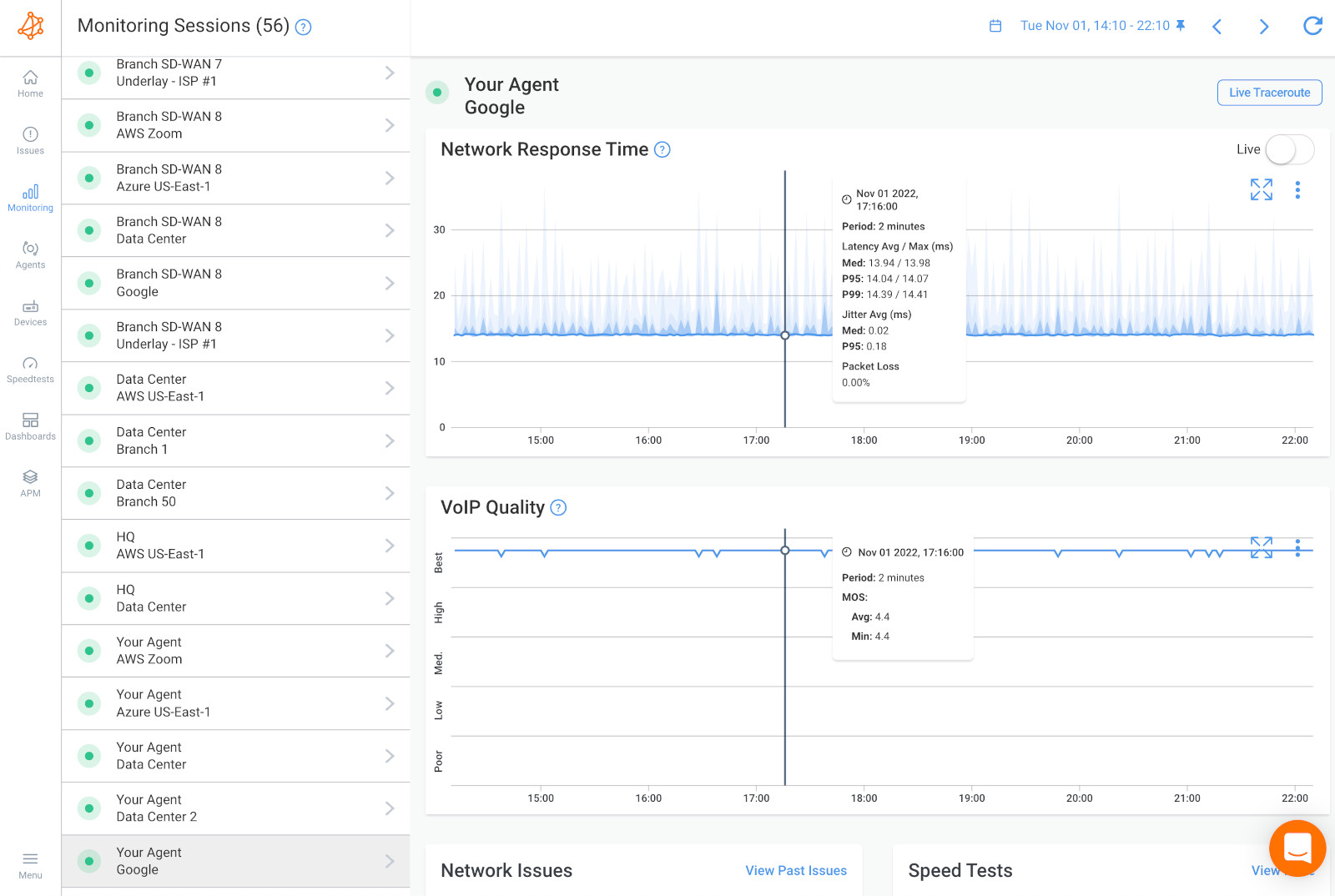
If network troubleshooting does not reveal any issues, the problem might be on the user's end. Install a Monitoring Agent directly on the user’s workstation to determine if there are any network issues from their POV.
If the issue is not related to the network, it might be a problem that can be resolved by IT specialists directly on the user's workstation or a remote destination. It could also be caused by other hardware-intensive systems, such as video conferencing systems, which use up significant resources like CPU and RAM. Obkio can also monitor these resource metrics for you.
If there’s a network issue on two network sessions, it means that the issue is happening on a shared network segment between the two sessions. In this case, the network issue is not specific to just one network segment but rather affects all the applications and services that rely on that network. This broader issue could stem from various sources such as the LAN, the firewall, or the local loop Internet connection.
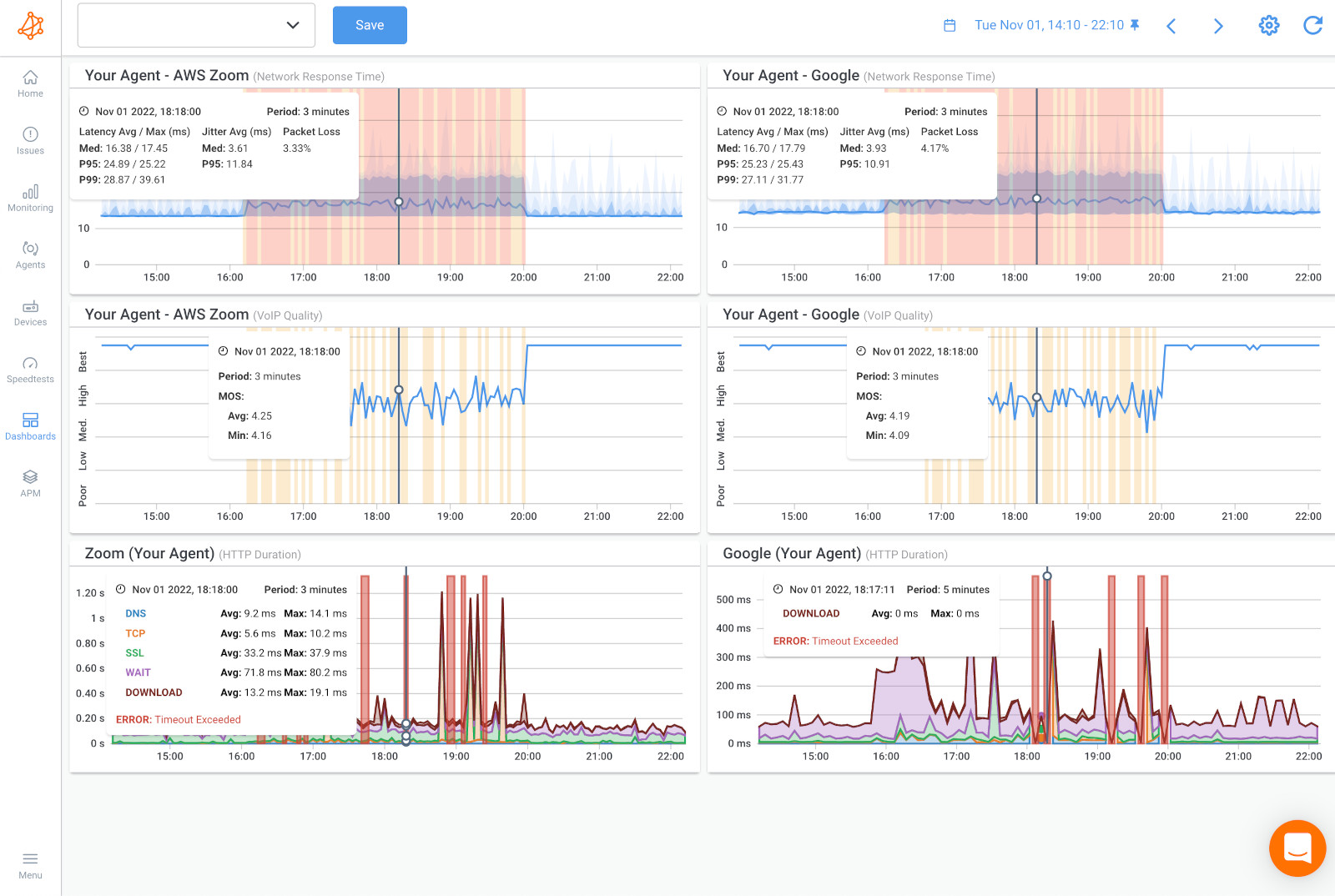
If you find the network issue on only 1 network session, This means that the network problem is happening specifically towards that specific location on the Internet and that the problem is further away.
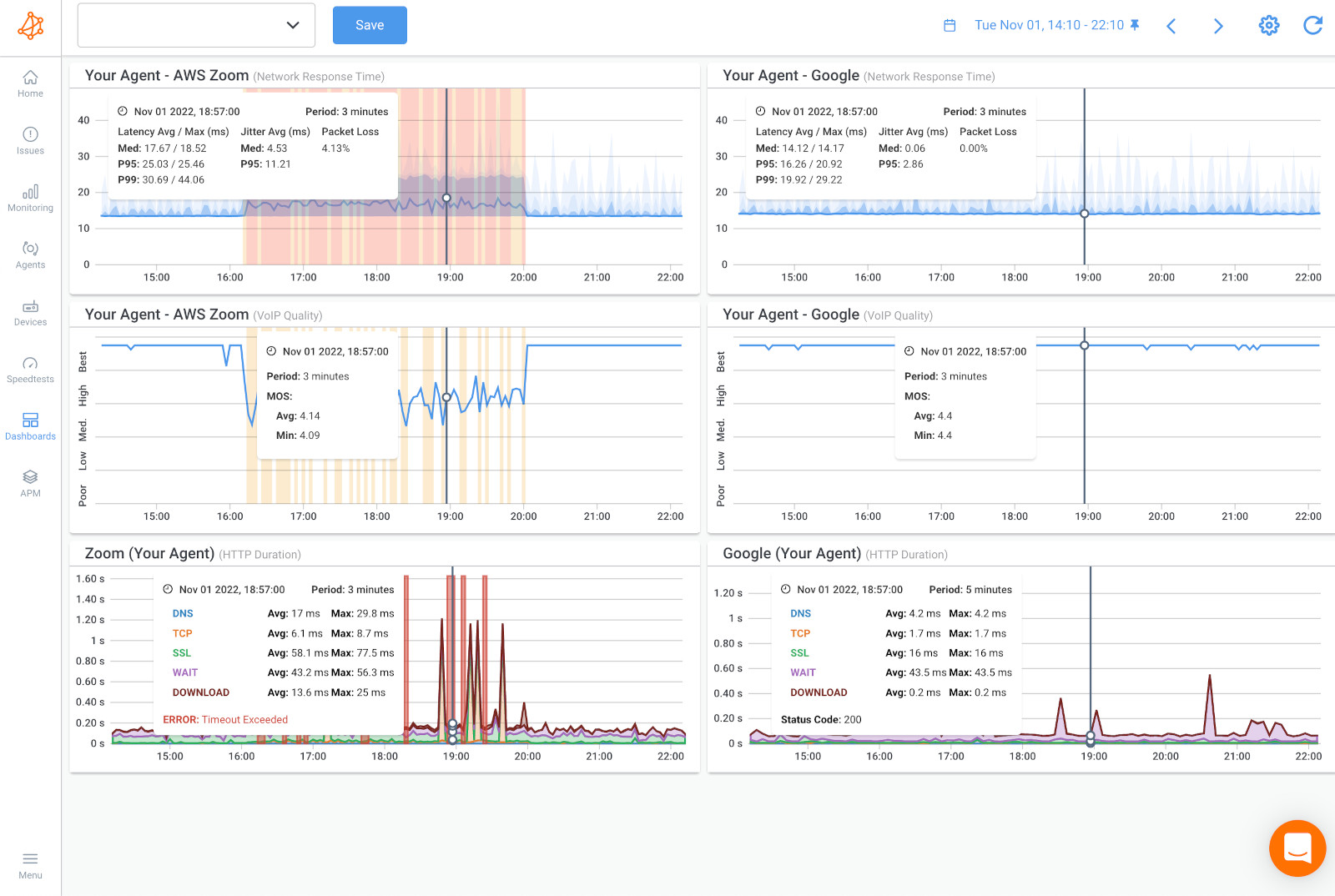
Once you confirm that the network issue is happening on both network sessions, it's clear that the problem lies within the network. To further pinpoint the issue, you can utilize Obkio's Device Monitoring feature to determine whether the problem is occurring within your own network or in your Service Provider's network.
By comparing data from different devices, you can gain insights into the location of the issue and take appropriate action to resolve it.
- CPU or Bandwidth Issues: When you compare your network data using Device Monitoring, you may detect CPU or Bandwidth issues. Resource issues likely mean that the network issue is on your end and you need to troubleshoot with your internal team.
- Internet Problems in Your ISP’s Network: If you don’t see any resource issues from your devices, this is a sign that the cause of the network issue is in your Service Provider’s network. In this case, you need to open a service ticket with as much information as you can collect. And, for your request to be taken seriously and be quickly escalated past 1st level support, you need to share as much information as you can.
After identifying the cause of network issues in your local network, there are various actions you can take to fix them. Below are some tips to address some of the most common causes of network issues:
- Slow network speeds: Slow network speeds can be caused by various factors, including network congestion, network overload, outdated hardware, or interference. To fix this issue, you can try restarting your modem or router, updating firmware or drivers, optimizing your network settings, or using a network booster.
- Network congestion: Network congestion occurs when there is too much traffic on the network, resulting in slow speeds and dropped connections. To fix this issue, you can try reducing network usage during peak hours, optimizing your network settings, upgrading your network hardware, or using a Quality of Service (QoS) feature to prioritize critical network traffic.
- Bandwidth issues: Bandwidth issues can occur when there is insufficient bandwidth to support the network traffic. To fix this issue, you can try reducing network usage during peak hours, upgrading your network hardware, optimizing your network settings, or implementing a bandwidth management solution.
- High CPU usage: High CPU usage can cause network performance issues by overwhelming network resources. To fix this issue, you can try reducing network usage during peak hours, optimizing your network settings, upgrading your hardware, or implementing a network monitoring solution to identify and address high CPU usage issues.
- Dropped connections: Dropped connections can occur when there is interference or signal loss between your device and the network. To fix this issue, you can try moving closer to your router, resetting your network devices, or changing your network settings.
- No Internet connection: If you have no Internet connection, you can try restarting your modem and router, checking your network cables and connections, and resetting your network settings.
- DNS errors: DNS errors can prevent your device from connecting to the internet. To fix this issue, you can try changing your DNS settings, clearing your browser cache and cookies, or flushing your DNS cache.
- Network security issues: Network security issues can include unauthorized access, malware, or viruses. To fix this issue, you can try running a virus scan, updating your security software, or changing your network password.
If your ISP is causing poor network connectivity, you can now collect the last bit of data about where exactly the network problem is located so you can share that information with your Service Provider. To do this, we’ll use Obkio Vision, Obkio’s free Visual Traceroute tool.
By using Traceroutes, the Network Map, and the Quality Matrix you’ll be able to identify if:
- The network issue is happening towards a specific location over the Internet. So only one specific site is being affected.
- The network issue is on your ISP’s side and you need to open a service ticket with as much information as you can collect.
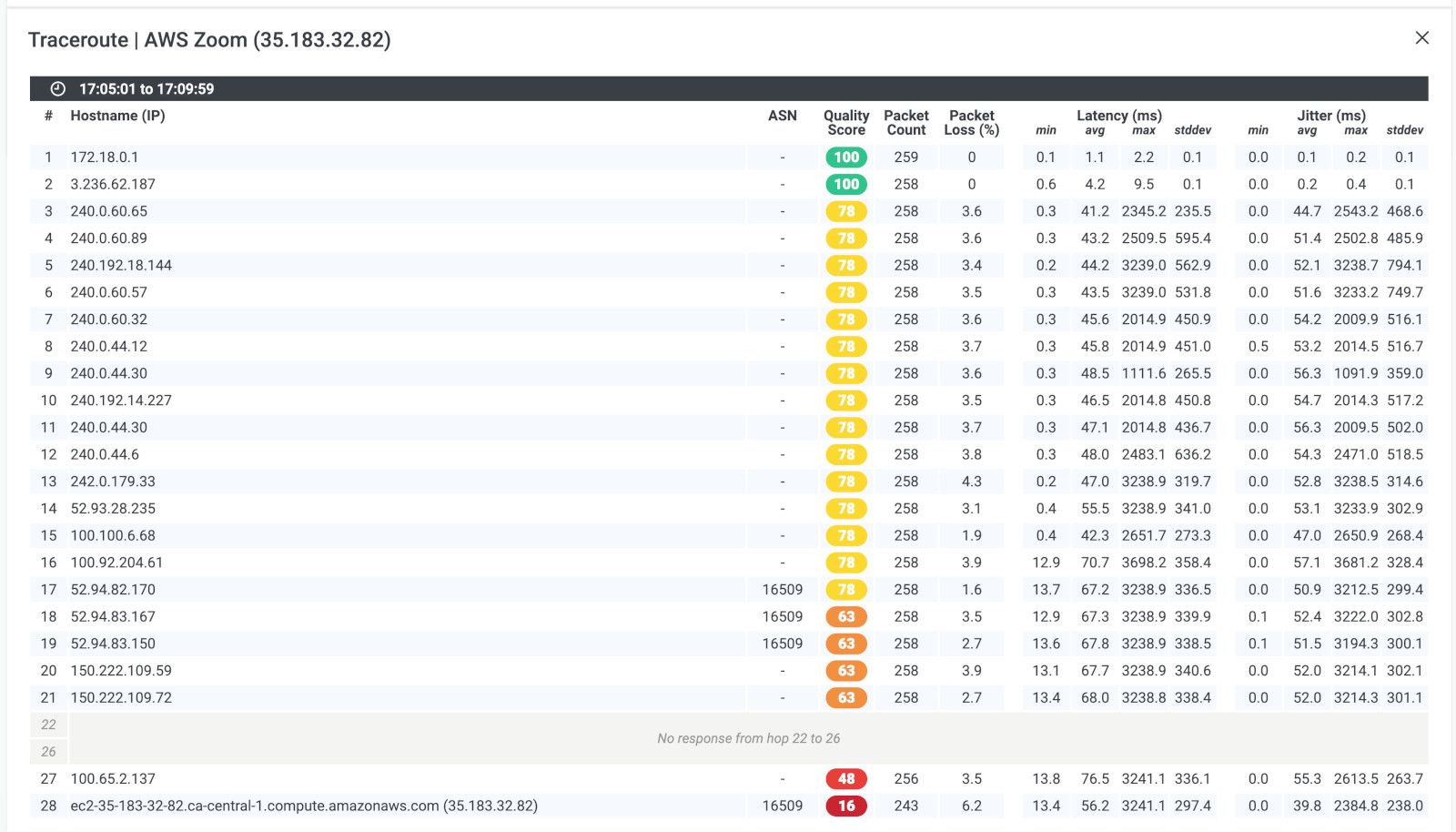
If the problem is in your ISP's Network:
- Contact your ISP to get technical support using the screenshots of Monitoring Sessions, Dashboards or Traceroutes in Vision.
- Share results of Live Traceroutes with your ISP using a public link.
- If your ISP wants to analyze your data further, you can create a temp
Establishing a performance baseline is a crucial step in improving network performance. It involves collecting and analyzing data over a period of time to determine the normal or expected behavior of the network, in order to understand when your base network performance is degrading.
To establish a performance baseline, network monitoring tools collect data on various network performance metrics. These metrics may include bandwidth utilization, latency, packet loss, device health, or application response time. The data collection process spans an appropriate timeframe to capture different network conditions and usage patterns.
Obkio measures and collects historical network performance data, so you can create your baseline, and then compare performance before you improve your network performance and after. You can easily browse through your historical performance data using Obkio’s graphs.
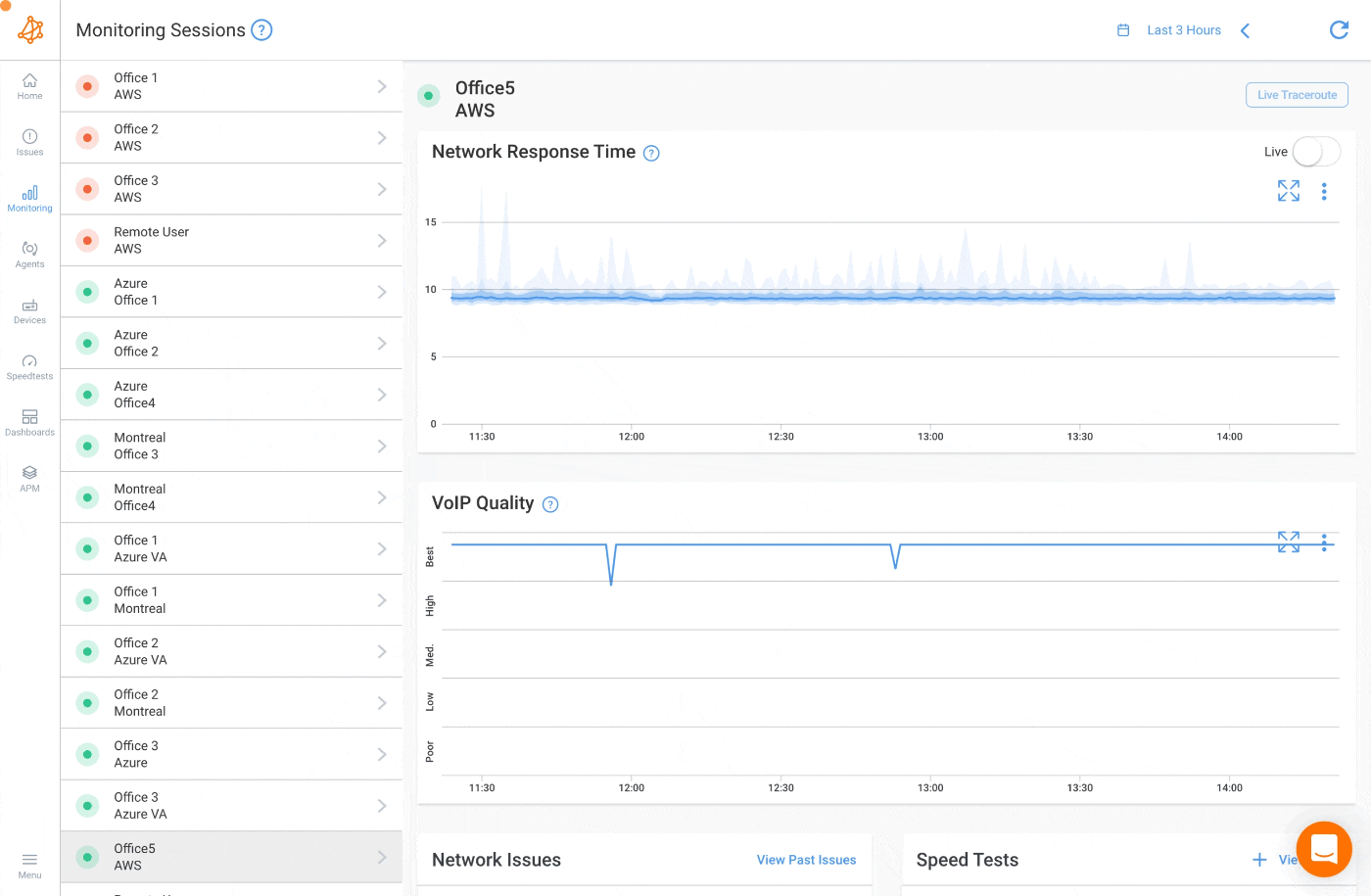

Let’s explore why baselines and historical data are so important:
- Data Analysis: Once the data is collected, it is analyzed to identify trends, patterns, and benchmarks. Statistical analysis techniques are often employed to understand the normal ranges, average values, and variations in performance metrics. This analysis helps in establishing a baseline for comparison in the future.
- Identifying Normal Behavior: By analyzing the collected data, you can determine the normal behaviour and performance levels of the network. This includes understanding typical usage patterns, peak traffic periods, and expected performance ranges for different metrics. The baseline reflects the network's performance under normal conditions.
- Deviation Detection: With a performance baseline in place, it becomes easier to detect deviations or anomalies from normal behaviour. By comparing current performance metrics with the established baseline, you can quickly identify performance issues, such as increased latency, excessive packet loss, or higher bandwidth utilization. Deviations from the baseline indicate potential problems that require investigation and resolution.
- Performance Optimization: The established performance baseline serves as a reference point for performance optimization efforts. By comparing current metrics to the baseline, you can identify areas where performance falls short and take targeted measures to improve network performance. It helps prioritize optimizations based on the identified gaps.
- Change Impact Analysis: When changes are made to the network infrastructure, configurations, or applications, the performance baseline becomes invaluable for assessing their impact. By comparing post-change performance metrics with the established baseline, you can determine if the changes have positively or negatively affected network performance. This analysis aids in identifying any unintended consequences of changes and taking corrective actions.
- Capacity Planning: The performance baseline provides insights into the network's capacity and helps in network capacity planning. By understanding the historical usage patterns and resource demands, you can anticipate future needs, identify potential bottlenecks, and allocate resources accordingly. This ensures that the network is adequately provisioned to meet current and future performance requirements.
- Continuous Monitoring and Iterative Baseline Refinement: Network performance is not static, and it can evolve over time due to various factors. Therefore, it is important to continuously monitor and refine the performance baseline to keep it up to date. As the network evolves, new data is collected, and the baseline is adjusted to reflect the current performance expectations.
Establishing a performance baseline provides a benchmark for measuring network improvements, optimizing performance, and detecting deviations from normal behaviour. It enables you to make data-driven decisions, enhance network capacity, and ensure a high-performing and reliable network environment.
Reporting and analytics play a crucial role in improving network performance. They provide valuable insights into network behaviour, identify performance bottlenecks, and guide decision-making for optimization efforts.
The information you can collect in Obkio Network Performance Monitoring tool gives you a precise and continuous view of your network performance and helps you understand if your network performance needs to be improved or optimized. Obkio’s Network Performance Reports feature helps you extract and analyze a large amount of data from Obkio’s App all at once.
- Summarize Data: Generate reports to view network metrics, show moments of network performance degradation, or highlight network issues.
- Download Reports: Download reports using a public URL. Users don’t need to have a user created in Obkio’s App to download reports.
- Share Reports: Send reports via email to a list of email addresses to send reports to multiple contacts at once.
- Schedule Reports: Schedule reports to run and be generated on a daily, weekly or monthly basis. Learn more about Report Schedules.
Here are some reasons why Network Performance Reports are key for improving network performance:
- Performance Metrics Visualization: Reports offer visual representations of network performance metrics. Through charts, graphs, and dashboards, you can easily understand and interpret the performance data. Visualizations provide a clear overview of key metrics, trends, and patterns, enabling you to identify areas of concern or improvement.
- Trend Analysis: Reports allow you to analyze historical data and identify performance trends over time. By tracking metrics like bandwidth utilization, network utilization, latency, or packet loss, you can identify recurring patterns, peak usage periods, or specific events that impact performance. Trend analysis helps in understanding long-term performance behaviour and detecting anomalies.
- Comparative Analysis: Reports enable you to compare performance metrics across different time periods, network segments, or devices. This comparative analysis helps in identifying performance variations, determining the impact of changes or optimizations, and assessing the effectiveness of performance improvement initiatives.
- Root Cause Analysis: Reports aid in root cause analysis by correlating different performance metrics. They provide insights into the relationships between various metrics, allowing you to identify the underlying causes of performance issues. For example, you can analyze the correlation between high latency and network congestion to pinpoint the root cause and take appropriate corrective actions.
- Real-time Monitoring and Alerts: Reports provide real-time monitoring capabilities, allowing you to track performance metrics in real-time. They generate network monitoring alerts and notifications when predefined thresholds are exceeded, enabling you to promptly address performance issues and minimize their impact. Real-time monitoring helps in proactive troubleshooting and quick response to network incidents.
Reporting and analytics empower organizations to make informed decisions, identify performance bottlenecks, and continuously improve network performance. By leveraging Obkio’s reporting feature, you can optimize network resources, enhance user experience, and ensure a reliable and high-performing network infrastructure.
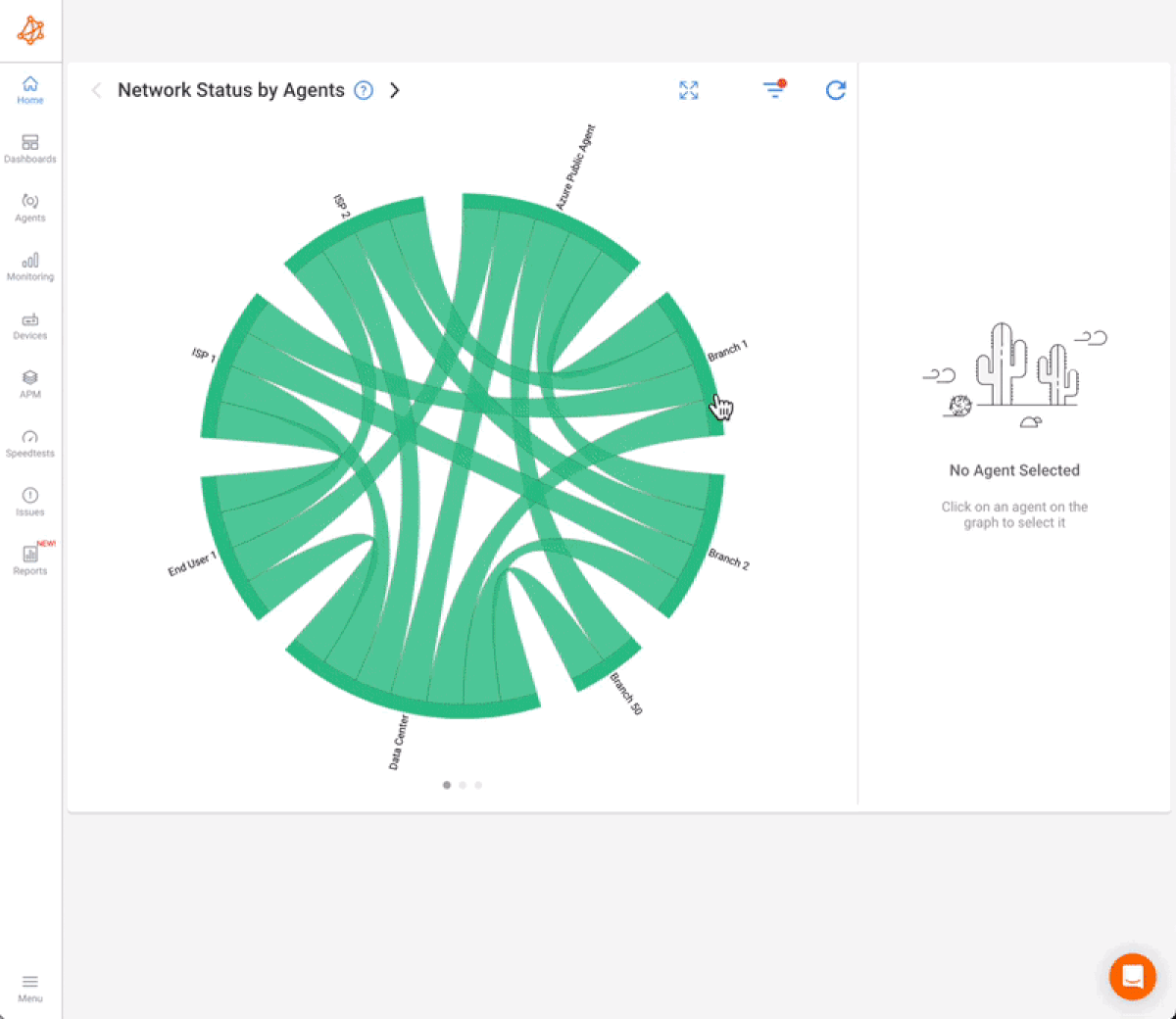
Woohoo! So you’ve identified and resolved issues impacting your network performance - and with your Network Performance Monitoring tool in place, you have continuous monitoring and proof that your network is performing beautifully.
But wait, it doesn’t end there. Networks don’t stay perfectly optimized forever, and network issues can always come back to haunt you. That’s why it’s important to keep Obkio as your permanent network admin, and always be prepared to improve your network performance as needed!
- Enhanced User Experience: Network performance directly impacts user experience. A slow or unreliable network can lead to frustrated users, decreased productivity, and negative customer experiences. By continuously improving network performance, you can provide users with fast, responsive, and reliable network connectivity, ensuring a seamless and satisfying experience.
- Increased Productivity: A high-performing network enables employees to work efficiently and effectively. Fast access to applications, quick file transfers, and smooth communication enhance productivity and collaboration. Continuously improving network performance ensures that employees can perform their tasks without unnecessary delays or disruptions, leading to improved overall productivity in the organization.
- Cost Efficiency: Proactively improving network performance can result in cost savings. By identifying and addressing performance bottlenecks, you can optimize network resources, avoid unnecessary investments in additional bandwidth or infrastructure, and reduce maintenance and troubleshooting costs. A well-performing network is more efficient in utilizing existing resources, minimizing operational expenses, and providing a better return on investment.
- Future-Readiness: Network performance requirements are constantly evolving with advancements in technology. The rise of cloud computing, IoT devices, and emerging technologies like 5G or edge computing introduce new challenges and demands on the network. By continuously improving network performance, you ensure that your network infrastructure is future-ready, capable of supporting emerging technologies and adapting to evolving business needs.

Are you a network admin or IT pro looking to improve network performance in your business network, or a remote worker trying to improve the performance of your home network? Whether you need to troubleshoot large networks or single-user workstations, Obkio's Network Monitoring Tool has plans tailored for you. Find the right plan to help you improve network performance with ease.
You’ve now made it to the end of this journey, and we want to make sure that you leave here with some tips in mind. When you’re looking to improve network performance, it’s important to follow the steps we mentioned - especially if you're a network administrator or IT professional for a business with a large enterprise network.
In this section, we're going to explore some quick and exciting ways to supercharge and improve your network performance:
- Bandwidth Optimization: Analyze your network traffic and prioritize critical applications. Implement Quality of Service (QoS) mechanisms to allocate bandwidth appropriately and ensure that important applications receive the necessary resources. For example, QoS for VoIP.
- Network Monitoring: Utilize network monitoring tools to continuously monitor performance metrics. Identify bottlenecks, bandwidth hogs, or latency issues in real-time. This enables proactive troubleshooting and optimization.
- Network Segmentation: Divide your network into logical segments or VLANs (Virtual Local Area Networks). This helps in isolating and managing network traffic effectively, reducing congestion, and improving overall performance.
- Network Hardware Upgrades: Assess your network infrastructure, including switches, routers, and access points. Outdated or inadequate hardware may limit performance. Upgrading to faster and more advanced equipment can enhance network speed and capacity.
- Network Security Measures: Implement robust security measures, such as firewalls, intrusion detection systems, and encryption protocols. Strong network security prevents unauthorized access, malicious activities, and potential performance degradation.
- Quality Cabling: Use high-quality Ethernet cables that support faster data transmission rates. Poorly terminated or damaged cables can cause signal loss, leading to slower network speeds and increased latency.
- Wi-Fi Optimization: Fine-tune your wireless network by optimizing channel selection, reducing interference, and strategically placing access points. This ensures optimal Wi-Fi coverage and minimizes signal degradation.
- Software and Firmware Updates: Regularly update network devices with the latest software and firmware releases. Updates often include bug fixes, performance enhancements, and new features that can improve network performance.
- Traffic Prioritization: Prioritize critical network traffic by implementing traffic shaping or bandwidth allocation techniques. This ensures that important applications receive sufficient bandwidth while non-essential traffic is limited.
- Network Redundancy: Incorporate redundancy measures, such as implementing redundant paths or backup connections. This ensures network availability and reduces downtime in case of failures.
- Network Optimization Tools: Leverage specialized network optimization tools that can analyze, diagnose, and fine-tune network performance. These tools offer insights into network behaviour, identify bottlenecks, and suggest optimization strategies.
- Regular Performance Assessments: Conduct periodic network assessments to identify performance gaps and areas for improvement. This includes measuring key performance metrics, analyzing trends, and making data-driven decisions for optimization.
By implementing these strategies, you can enhance network performance, improve user experience, optimize resource utilization, and ensure a robust and reliable network infrastructure for your organization.
In this article, we should you how to improve network performance using NPM tools - that’s because they’re the most complete solution for monitoring and improving every end of your network. But, here’s a list of tools you can use depending on your network’s needs and issues:
- Network Performance Monitoring (NPM) Tools: Network Performance Monitoring (NPM) Tools, like Obkio, provide real-time monitoring and analysis of network performance metrics such as bandwidth utilization, latency, packet loss, and device health. They help identify bottlenecks, troubleshoot issues, and optimize network performance.
- Network Diagnostic Tools: These tools assist in diagnosing network problems by performing tests and generating reports on network connectivity, latency, packet loss, and route analysis. They help pinpoint the root causes of performance issues and guide troubleshooting efforts.
- Traffic Analysis Tools: These tools analyze network traffic patterns, protocols, and bandwidth consumption. They provide insights into application usage, identify bandwidth-intensive applications, and help optimize traffic flow for better performance.
- Network Configuration Management Tools: These tools help manage and optimize network configurations, ensuring consistency and adherence to best practices. They provide a centralized platform to automate configuration tasks, track changes, and maintain network performance.
- Bandwidth Management Tools: These tools assist in optimizing bandwidth usage by prioritizing critical applications, controlling bandwidth allocation, and implementing traffic shaping policies. Network Bandwidth Monitoring Tools help ensure that important network traffic receives the necessary resources for optimal performance.
- Network Security Tools: These tools focus on protecting the network from security threats, including intrusion detection and prevention systems, firewalls, antivirus software, and vulnerability scanners. Ensuring robust network security enhances performance by preventing unauthorized access and mitigating potential attacks.
- Network Optimization Tools: These tools analyze network performance, identify bottlenecks, and suggest optimization strategies. They help optimize network configurations, improve routing efficiency, and enhance overall network performance. NPM tools, like Obkio, are always network optimization tools.
- Network Simulation Tools: These tools simulate network environments to test and validate performance under different conditions. They help predict the impact of changes or upgrades, optimize network designs, and ensure performance meets desired requirements.
- Network Inventory and Documentation Tools: These tools provide a comprehensive inventory of network devices, configurations, and dependencies. They assist in maintaining accurate network documentation, streamlining troubleshooting efforts, and optimizing network performance.
- Cloud-based Network Management Platforms: These platforms offer centralized network management, monitoring, and optimization functionalities. They provide a unified view of network performance, automate tasks, and enable remote network monitoring for improved performance across distributed environments.
Each of these tools plays a unique role in helping you optimize and improve network performance. Depending on your specific needs and network requirements, leveraging the right combination of tools can significantly enhance the performance, reliability, and security of your network infrastructure.
Choose your Ultimate Fighter: Network Performance Monitoring tool to ensure optimal network performance. Learn about the types of tools, features & uses.
Learn more

In this article, we focused on improving network performance, but there are various aspects of your network you may want to optimize depending on your business', or personal network's needs.
Network improvement as a whole refers to the process of enhancing the performance, reliability, security, and efficiency of a computer network. As we mentioned, network improvement can go beyond just performance, and some common aspects of network improvement include:
Performance Optimization: This involves measures to increase network speed, reduce latency, minimize packet loss, and improve overall throughput. It may include upgrading hardware components, optimizing configurations, and implementing Quality of Service (QoS) policies.
Reliability Enhancement: Network improvement often focuses on making the network more reliable and resilient to failures. This can include redundancy in critical components, implementing failover mechanisms, and ensuring backup systems are in place.
Security Enhancement: Network security is a key aspect of improvement, involving measures such as implementing firewalls, intrusion detection systems (IDS), encryption protocols, access controls, and regular security audits.
Efficiency and Scalability: Improving network efficiency involves optimizing resource utilization, minimizing network congestion, and ensuring scalability to accommodate growing demands. This may involve load balancing, traffic shaping, and capacity planning.
Management and Monitoring: Effective network improvement also includes robust management and monitoring practices. This can involve using network monitoring tools to track performance metrics, identify issues proactively, and make data-driven decisions for continuous improvement.
Network improvement is a continuous process that aims to enhance the overall functionality and performance of a computer network to meet the evolving needs of users and applications while ensuring reliability, security, and efficiency. So understand which aspects of your network you need to improve, we recommend starting with a Network Assessment!
And there you have it, fellow network adventurers! We've journeyed through the realms of network optimization, armed with strategies and insights to conquer the challenges that hinder our network's performance. But before we part ways, there's one secret weapon that can truly take your network performance to new heights: Obkio!
Obkio, the mighty guardian of network performance, stands ready to lend you its power. With its arsenal of monitoring and diagnostic tools, Obkio empowers you to uncover hidden performance issues, troubleshoot with ease, and unleash the full potential of your network. It's like having a trusty sidekick by your side, helping you keep your network in top shape.
So, fellow network enthusiasts, don't let network performance woes weigh you down. Harness the strength of Obkio and embrace a network that's fast, reliable, and ready for any challenge. Together, we can conquer the realm of network performance and embark on a future filled with seamless connectivity and remarkable user experiences.

Now, it's time to gear up, embrace the Obkio advantage, and let your network performance soar to unprecedented heights. Unleash the power within, and may your network always be the hero of the digital realm!
- 14-day free trial of all premium features
- Deploy in just 10 minutes
- Monitor performance in all key network locations
- Measure real-time network metrics
- Identify and troubleshoot live network problems

You can rest assured that we're not like those pushy Sellsy people - there's no catch here. We firmly believe in the excellence of our product, but if it's not the right fit for you, we understand and want what's best for you.
 Obkio Blog
Obkio Blog





